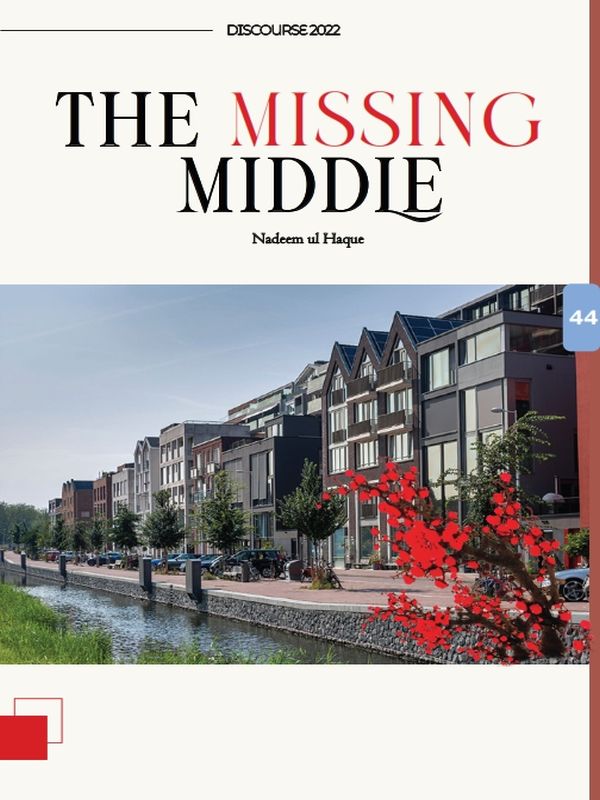The Missing Middle
About two decades ago, I wrote an article entitled “where are the tower cranes?”
Since then, the question has been asked many times. Yet there are very few tower cranes to be seen in Pakistani cities even today.
In most parts of the world, development is virtually symbolized by the presence of tower cranes. Rapidly growing cities such as Dubai, Shanghai, Seoul, Hanoi and others have sported a jungle of tower cranes to demonstrate their transformations. Even mature cities such as London New York and Washington display many tower cranes to show that cities are hubs of construction and rejuvenation.
Only in Pakistan do administrators refuse to allow cities to evolve other than in the horizontal direction. Sprawl based on housing societies remains the paradigm for cities, possibly because a) the colonials mandated it, and b) we do not have the brainpower to develop a new consensus.
City managers (mostly PAS officials) believe that nothing should go higher than two stories. They also believe that homes are separate single-family units owning their own land and two stories only! They also believe that cities are only government offices, convenience shops and widely spaced-out single-family homes with lots of roads, flyovers, and signal-free corridors for cars to whizz about!
In their world there is no room for playgrounds, community spaces, educational spaces, public spaces, libraries, expansive commerce, and many other forms of human activity.
This vision has led to Plotistan where cooperative housing societies have mushroomed in the world of plots and single-family houses! The flawed model is fraught with illegalities, scams, building delays and all forms of other undesirable activities. Yet city administrators resist plans to densify cities by allowing flats and mixed/multiple use buildings with more room for pedestrians and bicyclists!
Pakistan has some of the largest cities in the world but most are devoid of public amenities – besides the use of the car. PAS city managers still resist parking and mobility policies. PIDE prepared a parking policy for Islamabad which is still awaiting consideration by officials.
The officials’ love for cars is such that poor housing and street vending is easily dispensed with to widen streets and build flyovers – thus compromising the mobility of the poor.
The question I wish to raise here is why there seems to be a strange infatuation with restricting buildings to two floors. The world over, cities allow low rise development, say, in the 3-10 floor range. For some reason our city managers prohibit this low-rise development too. Often the reasoning for this that there will be no parking space for cars. Do only people with cars have the right to breathe?
In most cities old neighbourhoods are decaying: Samanadad in Lahore, Satellite town in Rawalpindi, Namak Mandi in Peshawar, and many others. Areas such as these are extremely well located but choked and crying out for rejuvenation. People are crowded in ancestral homes waiting to build upon them and receive a market value of the property or allow their family to expand into a better home. In some cases, the area has moved to greater commercial activity and people wish to exploit this potential. In short, their potential wealth has increased waiting for the regulator (PAS officials) to allow them to realize it.
Similarly, areas like Raja Bazaar, Hall Road, Brandreth road, even Mall Road Lahore are all congested vibrant shopping areas. They are growing without room to expand. They could expand upwards or even into a warehouse style shopping mall with underground parking if only the regulator (PAS officials) would allow them to develop their properties.
As an economist, I keep imagining the possibility of neighbourhood rejuvenation as an opportunity to expand our investment opportunities.
Question: What if we allowed all old houses that for decades have been restricted to 2 floors to go up by 3 or 4 floors? In most countries houses are allowed to go to 3 to 5 floors. In Pakistan, for some bizarre reason, we are stopped from doing this by the PAS. Families have expanded and are crowded into the old house that was meant for a small nuclear family. Why not let them build and live in comfort?
The current PAS model is that you can’t build up in the inner city but must wait for housing colonies to develop way outside cities and then build a house there. Housing societies take two decades to develop and are fraught with fraud and delays. Moreover, they are miles outside the city and places where people have lived their lives. It takes a lifetime to make this costly transition. Most families cannot afford to have their savings tied up in risky housing societies – which often only lead to loss.
While I initiated the debate on high rise and flats some thirty years ago, I now realize that what is missing is the middle—letting people develop ancestral properties to develop their neighbourhoods. This will unlock investment and employment and develop cities without dislocating people and neighbourhoods.
Allowing the middle to develop will promote well-being at every level. I appeal to our PAS city managers to allow the middle to develop. All it takes is a rule change. Remove the 2-floor restriction and let people go up 2-3 floors higher. Of course, some may not be able to go higher given the state of their construction. But let each family have the choice.
This is also a simple win-win for the housing shortage.
Of course, this proposal will not sit well with the current silly requirement that cars must be accommodated before people. Even in current congestion, people are parking their cars.
Let floors be built and let people use paid street parking or parking lots.
The author is the Vice Chancellor of the Pakistan Institute of Development Economics (PIDE), Islamabad.




